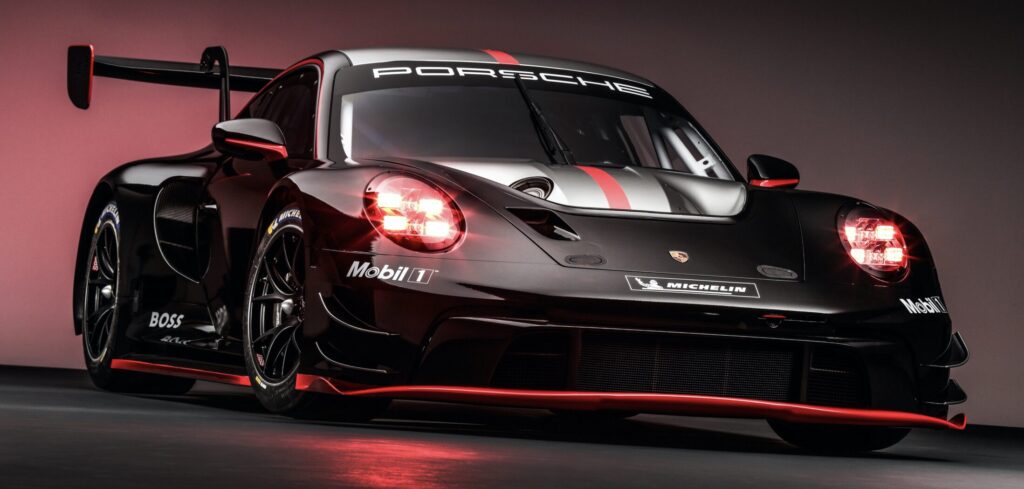Porsche’s latest generation 911 GT3 R was unveiled at last weekend’s 24 Hours of Spa-Francorchamps. Available to customers for the 2023 season, the car’s headline changes include a larger capacity engine, in addition to aerodynamic refinements to ensure more consistent performance and improved balance.
The GT3R is only the second race car Porsche has released based on the 992 platform. Development has been underway since 2019, with a focus on improved driveability for professional and gentleman drivers alike. Attention was also paid to ensuring the car had sufficient performance reserves to account for BoP (Balance of Performance) tweaks in the various series it is eligible for, while also improving its serviceability and lowering running costs.
“The new 911 GT3 R has big shoes to fill,” said Michael Dreiser, sales director at Porsche Motorsport. “Its forerunner has won almost everything there is to win in the GT3 scene in four seasons since 2019. Its stand-out successes include overall victories at the 24-hour races at the Nürburgring and also here at Spa-Francorchamps. Raced by our customers, the predecessor scored class victories at the 24 Hours of Daytona and the 12 Hours of Sebring. The new model faces a massive workload in the hands of the Porsche customer racing teams.”
Notably, after the GT3 class was announced as a professional category in the North American IMSA series, the FIA WEC World Endurance Championship followed suit. From 2024, GT3 racing cars will be eligible to take part in the 24 Hours of Le Mans for the first time, placing even greater demands on both Porsche’s customer teams and equipment.
“We hit the bull’s eye with the enormously successful predecessor. Accordingly, the bar for its successor is high,” added Sebastian Golz, 911 GT3 R project manager at Porsche Motorsport. “Our task was less about making the new 911 GT3 R even faster – the classification within performance windows set by the BoP quickly cancels out this advantage. For us, it was primarily about our customers being able to drive the racing car fast for longer. This requires durability and that’s why we focused predominantly on improved driveability. This is reflected in the new 4.2-liter engine’s broader usable rev band, more stable and constant aerodynamics and lower loads on the rear tires, which allow their potential to last longer.”
Porsche states that the engine is a near standard roadgoing unit from the 992 gen 911, with a displacement of 4,194cc compared to the old GT3 R’s 3,997cc, with peak power now hitting 565bhp, with torque improved across the RPM range.
When designing the car, Porsche tilted the engine forwards by 5.5°, creating more leeway for the underbody diffuser. Auxiliary units such as the alternator and the air conditioning compressor have been moved forward and further down into a space in front of the engine and gearbox, which has a positive effect on the weight balance of the car.
The suspension features double wishbones at the front axle and a multi-link setup at the rear, with five-way adjustable dampers from KW all around. Suspension geometry changes are achieved with the use of shims, allowing for quick setup without the need for time consuming realignment.
Porsche notes that the positioning of the central pivot points at the front axle frees up space for the aerodynamic “race underfloor” concept. Like in the 911 RSR, this elevated underbody enables a clean flow of air to the rear diffuser and reduces the pitch sensitivity of the car. The rear wheels have been moved further back, which extends the wheelbase from 2,459mm to 2,507mm, reducing the load on the rear tires (a constant challenge for almost every racing 911) and improves the consistency of the tires’ performance over longer stints.
Porsche has also sought to further improve safety compared to the GT3 R’s predecessor. For example, the seat has been moved closer to the center of the car, allowing for integration of FIA-approved side protection panels. Porsche says it also further optimized the six-point safety harness: the tongues now slide even faster into the clasp via special ramps – saving about a second during pit stops for driver changes.
Meanwhile, the LED headlights rely on so-called collimator technology, which Porsche developed for the new LMDh 963 prototype, among others. This device works like a magnifying glass, only in reverse. It illuminates a particularly large area of the racetrack and is a significant improvement on the predecessor model, which was already regarded as the class leader.



